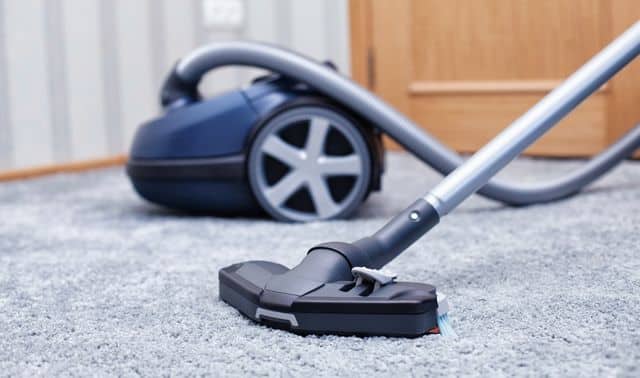Sign up for the Family Tree Newsletter Plus, you’ll receive our 10 Essential Genealogy Research Forms PDF as a special thank you!
Get Your Free Genealogy Forms
"*" indicates required fields
When you do your spring cleaning, you’re re-enacting a ritual your ancestors have performed annually for as long as houses have been getting dirty. Spring was the only time rugs were cleaned, because they had to be hauled outside and beaten to extract the accumulated grime. Then, in a flurry of invention about 100 years ago, a better way emerged: the vacuum cleaner.
Evolution of the Vacuum Cleaner
Since the mid-1800s, inventors had been tinkering with answers to the dirt deposited by the Industrial Revolution. Credit for the first vacuum cleaner belongs to Daniel Hess of West Union, Iowa, who patented a device in 1860 he called a “carpet sweeper.” In addition to a rotating sweeper brush, Hess’ gizmo had an elaborate bellows system on top that generated suction, pulling air through two “water chambers” to capture dust and dirt. But there’s no evidence his pioneering invention was ever produced commercially.
Other carpet sweepers, minus the suction feature, reached the market as well. The best-known was invented by Melville Bissell in 1876, after his wife, Anna, complained about the sawdust in the Grand Rapids, Mich., crockery shop they owned. After her husband’s death in 1889, Anna Bissell took over the company, becoming America’s first female CEO.
Bissell still produces a carpet sweeper based on Melville’s original design (although it’s no longer made from hog bristles secured with string). In the 1950s, the company pioneered home carpet shampooing.
Development of a true vacuum cleaner continued, although inventors struggled with how to generate the necessary suction. The Whirlwind, invented in Chicago by Ives W. McGaffey in 1868, required the operator to turn a hand crank while simultaneously moving the device across the floor. In 1899, John S. Thurman of St. Louis patented one of the first carpet cleaners powered by a motor rather than by muscle. But his “pneumatic carpet-renovator” blew instead of sucked, herding dust with jets of air.
It’s likely that Thurman inspired Hubert Cecil Booth, an English engineer who coined the name vacuum cleaner and is most often credited with inventing a motorized one. Booth later wrote of attending “a demonstration of an American machine by its inventor” at London’s Empire Music Hall: “I asked the inventor why he did not suck out the dust. … The inventor became heated, remarked that sucking out dust was impossible and that it had been tried over and over again without success; then he walked away.”
Undaunted, Booth performed a small experiment in a restaurant. He placed a handkerchief on a chair, put his mouth to the handkerchief and sucked in. Seeing how much dust he’d collected, Booth set out to build a machine that could do the same. Patented in 1901, his Puffing Billy was so big it required a horse-drawn cart to reach a customer’s home. With the oil-fueled engine parked outside, a cleaning crew hauled hoses inside through doors and windows.
After seeing Puffing Billy in action at Westminster Abbey for the 1902 coronation of King Edward VII, “the crowned heads of Europe” were so impressed “that they all wanted a similar machine.” Wealthy society ladies threw vacuum cleaner parties where guests sipped tea and lifted their feet for Booth’s uniformed crew. During World War I, Booth’s machines sucked 26 tons of grime from London’s Crystal Palace, helping stem a spotted-fever outbreak among sailors billeted there.
Booth founded the British Vacuum Cleaner Co., which produced the successor to Puffing Billy, the Goblin. Although the Goblin later lost out to the Hoover in the household market — even today, vacuuming is called “hoovering” in England — the company branched out into industrial cleaning and other household electronics. (The latter included the 1947 Teasmaid, “a Unique Electric automatic Tea-making and Alarm Clock Combined appliance; it makes Tea, Lights the Lamp, Wakes you up.”)
The prospect of hoovering began with James Murray Spangler, an asthmatic janitor in a Canton, Ohio, department store. Weary of wheezing from the dust he swept up, Spangler combined a tin soapbox, broom handle, pillowcase, electric fan and rotating brush into a “suction sweeper,” which he patented in 1908. Among his first satisfied customers was his cousin Susan, wife of William H. Hoover, who owned a leather-goods company and was looking to diversify. Spangler lacked the resources to commercialize his invention, so he sold the patent to Hoover.
The first product of the Electric Suction Sweeper Co., the Model O, weighed 40 pounds and sold for $60 in 1908 (equivalent to $1,440 in today’s dollars). Given the price tag and the vagaries of early electricity, the Model O was a tough sell. Hoover commissioned door-to-door vacuum-cleaner salesmen who offered in-home demonstrations and a 10-day free trial.
Manually operated vacuum cleaners persisted, many requiring one person to move the nozzle while another operated the pump. This inconvenience was neatly obscured in the 1910 Sears & Roebuck catalog, which explained “what a vacuum cleaner in your home means to you” — saving time and labor and “protecting the health of your family.” That same year, when Good Housekeeping magazine asked, “Do vacuum cleaners clean?” the responses were mixed.
By 1920, however, the spread of household electricity had helped vacuum cleaner sales top $35 million and a million units. Later that decade, Hoover introduced its beater bar, which “beats as it sweeps as it cleans.” Throwaway paper vacuum bags replaced cloth sacks. Bakelite plastic and magnesium alloys made machines lighter and more maneuverable.
The postwar spread of the suburbs, with their wall-to-wall carpeting, made the vacuum cleaner at last ubiquitous. But innovation didn’t stop: In the 1980s, British industrial designer James Dyson developed a vacuum cleaner that needed no bags. Instead, “cyclonic separation” with 150,000 Gs of centrifugal force shoots the dirt into the Dyson’s removable collection vessel.
As the 21st century dawned, vacuuming robots such as the iRobot Corp.’s Roomba promised to do the cleaning for us whenever needed — not just in the spring.
Timeline of the Vacuum Cleaner
1860: Daniel Hess receives the first vacuum cleaner patent
1876: Melville Bissell invents the carpet sweeper
1899: John S. Thurman develops gasoline-powered vacuum cleaner
1901: Hubert Booth invents the electric vacuum cleaner
1908: James Spangler patents what will become the Hoover
1909: Eureka offers the first vacuum-cleaning attachments
1920: Disposable vacuum-cleaner bag introduced
1969: First self-propelled vacuum
1979: Black & Decker introduces the Dustbuster
1993: James Dyson markets his cyclonic cleaner
2002: iRobot releases the Roomba
From the May 2011 issue of Family Tree Magazine
Related Reads
ADVERTISEMENT








